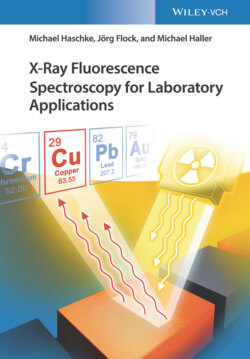Читать книгу X-Ray Fluorescence Spectroscopy for Laboratory Applications - Michael Haschke, Jörg Flock - Страница 34
3.3 Preparation of Compact and Homogeneous Materials 3.3.1 Metals
ОглавлениеMetals here mean both pure metals and metal alloys. This may be a wide variety of iron alloys, nonferrous metal alloys, or hard metals.
The preparation of metals for a measurement depends on the starting material as well as on the analytical task. Casting from the melt is possible. In the case of inhomogeneous alloys, remelting is also possible. The resulting specimens first have to be adapted to the geometry of the respective measuring instrument by mechanical processing, such as cutting, drilling, or sawing and then a clean and plane surface must be prepared by milling, grinding, or polishing. For the sampling from liquid melts, probe samplers are available with which, under reproducible conditions, homogeneous samples can be produced whose external form is directly fitted for the measuring instruments (see Figure 3.5). For castings, depending on the casting mold, removal of a surface layer is required to eliminate the influence of surface segregation and corrosion. Castings should always be produced under the same conditions, i.e. temperature and mixing of the melt, cooling rate, and sample geometry to ensure high reproducibility.
Conversely, the material to be analyzed can also present a compact metal body that already has been subjected to mechanical deformation, e.g. plates, bars, or tubes; they must be prepared by modifying the shape and by processing the surface to a measurement sample. The aim is always to produce a homogeneous sample with low surface roughness.
Figure 3.5 Specimen generated by sampling from a melt.
Figure 3.6 Influence of surface roughness on the measured fluorescence intensity.
Source: According to Willis et al. (2014).
Usually, the surface roughness obtainable by grinding or milling is sufficient for the analytical task. If a surface treatment is required by polishing, care must be taken that the polishing agent does not penetrate into the sample and cause contamination. This is especially likely in the case of relatively soft sample matrices, such as aluminum samples, in conjunction with hard polishing agents. This effect can be avoided by using other surface processing methods, such as milling. For hard sample matrices, polishing is often the only way to process the sample surface. Here, the risk of contamination is relatively low and can be largely avoided by subsequent cleaning procedures, for example, washing in an ultrasonic bath.
The measured intensities can be influenced by the surface roughness of the samples. It should be taken into consideration that this influence is greater for small fluorescence energies, in particular for heavy matrices, but smaller for high fluorescence energies in light matrices. The dependence of the measured fluorescence intensities of pure metals on the surface roughness of the sample is shown in Figure 3.6.
